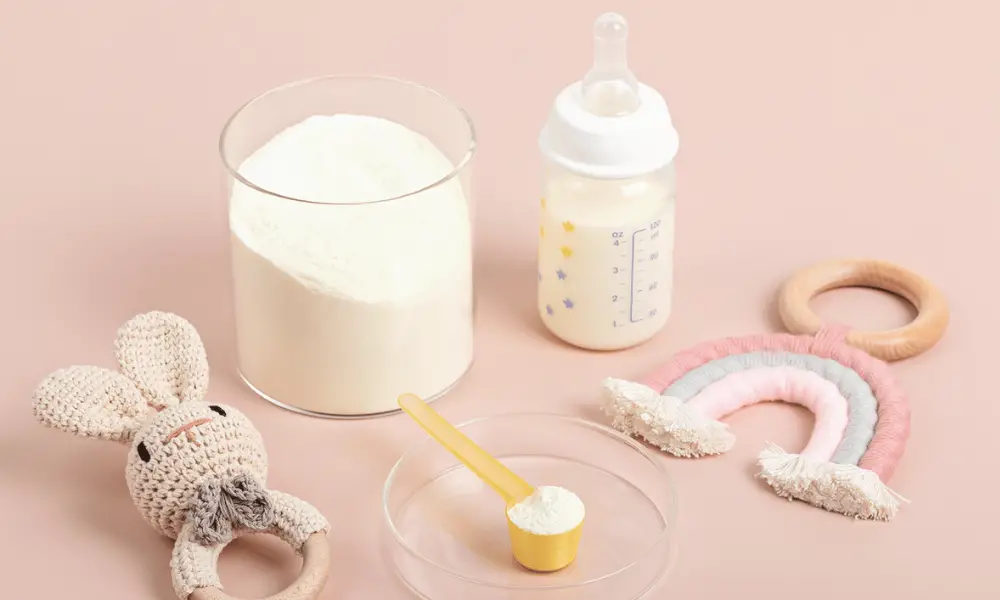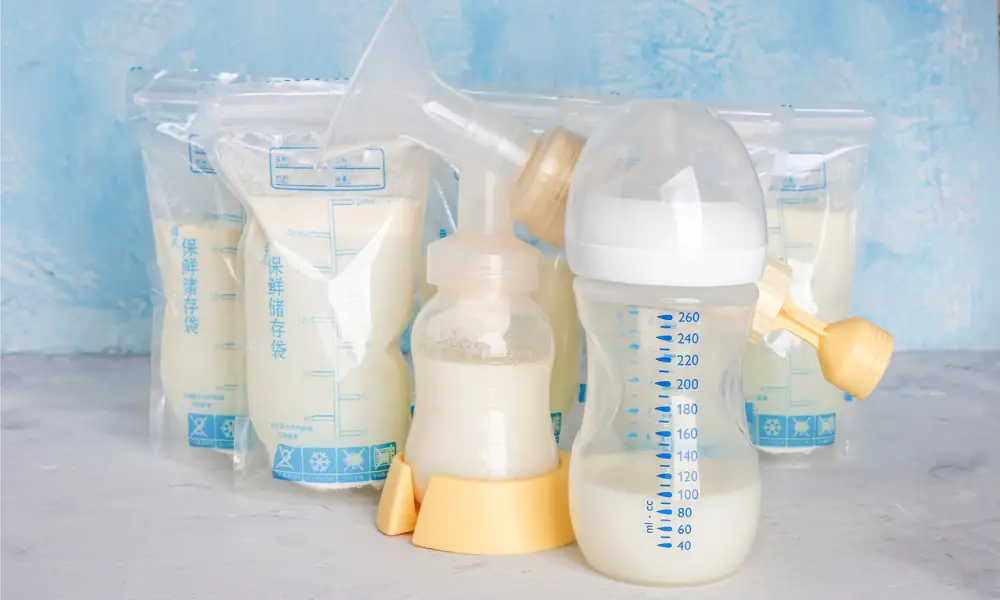For a variety of reasons, new mothers may choose to pump. They would have to leave the infant alone for nine to ten hours to continue work. Or perhaps they have a hard time getting the infant to latch. They might even have to leave the house to run a few errands. Pumping and giving the infant milk in these circumstances is helpful.
After researching which pump to purchase, determining your pumping schedule and volume, and starting to pump, the most crucial concern is how to store breast milk. After all, you wouldn’t want to witness your priceless milk being spoiled or unfit for ingestion following the efforts made for pumping. Breastmilk should be stored according to how and when it will be used.

How to Store Breast Milk After Pumping?
For both frozen and refrigerated storage of breastmilk at home, the following recommendations are valid:
For four hours, you can keep breastmilk at room temperature (up to 25 degrees Celsius).
Breastmilk can be kept in the refrigerator for up to 24 hours at temperatures below four degrees Celsius. Breastmilk can occasionally be stored in the refrigerator for three to five days in colder countries; however, opening and closing refrigerator doors in hotter regions makes extended storage more challenging.
Breastmilk should only be stored for two weeks in smaller refrigerators with only a freezer section.
You should only store breastmilk for 24 hours in an insulated cooler or box loaded with ice packs (such as the one you might bring to and from work).
Breastmilk may typically be kept in a freezer (at a temperature of about -18 degrees Celsius) for three to six months, depending on the climate where you reside and how often the freezer is opened and closed.
Other basic pointers for using and storing breastmilk include the following:
Colors in breastmilk might differ. A small percentage of milk will have a blue, yellow, or perhaps brown appearance.
When breastmilk separates, the fatty cream typically rises naturally to the top. To get it to combine again, give it a little shake.
Before giving milk to your Baby, give it a sniff. If the milk smells particularly unpleasant, avoid giving it to infants.
Always plan and save breastmilk in the exact quantity you will need.
Label everything clearly to prevent wasting milk or using it on separate days (thus, leading to the possibility of spoiling).
What are the Different Ways to Freeze Breast Milk?
Immediately after it has been expressed, breastmilk should be frozen and kept at a temperature of about -18 degrees Celsius.
For breastmilk that is being frozen, the following guidelines and suggestions apply:
Leaving some room at the top of the bag is advised if you freeze the milk because it tends to expand.
Ensure that bottles or bags are well-sealed, and never leave breastmilk in the open.
When milk is taken out of storage from being frozen, it should be shaken briefly to help it come back together. Frozen milk frequently separates when it is withdrawn from storage.
Keep frozen milk in the freezer’s back section to reduce contact with the food.
How can Breastmilk that has been Freeze-Dried be Thawed?
Breastmilk should be kept in the refrigerator for around 12 hours to defrost. Given the time required for the thawing process, it is typically best to do this the night before the day you will need to feed your Baby.
When thawing breastmilk, go by the following guidelines and suggestions:
- You should avoid letting breast milk thaw at room temperature when possible.
- Breastmilk that has once been thawed should never be frozen again.
- It is acceptable to keep the breastmilk in hot water and gradually raise the temperature to defrost it more quickly.
- Never try to heat breast milk on the stove or in the microwave.
How to Warm Breastmilk?
Breastmilk should be placed in a hot water container so that it can absorb some of the heat from the water around it. First, warm up the water you’ll be using in a small container. Place the container of frozen milk into the container to thaw it out.
How to Pump Breast Milk? To defrost breastmilk, the following guidelines and suggestions are applicable:
- Use a bottle warmer to warm the milk for your youngster to drink.
- Never use a microwave or a stove to reheat breast milk.
- Breastmilk that has previously been warmed shouldn’t be attempted to be stored.
Beginning of Pumping
You might wish to start pumping a few weeks before going back to work, going to school, or being away from your child for any other reason. Your Baby will have time to become used to feeding from a bottle while you can practice pumping.
How Frequently to Pump
Try to pump as frequently as your Baby is taking breast milk when you are away from your Baby or if you exclusively pump your milk. Thanks to this, your body will be reminded to continue producing the necessary quantity of milk.
How Much to Pump
Your body should be able to produce approximately the amount of milk your Baby requires if you pump as frequently as your Baby regularly consumes breast milk. As the Baby grows, this amount may shift and vary from one infant to the next. Consider adding a pumping session to enhance your milk supply if you discover that you cannot produce as much milk as your infant requires while you are away.
What Flavor and Smell does Breast Milk have?
Breast milk tastes like milk, but not the same kind of milk you’re used to from the grocery store. “Heavily sweetened almond milk” is the most frequently used description. What each parent eats and the time of day impact the flavor. Here’s what some mothers who have tried it have to say about how it tastes:
Sugar water and cucumbers
Melted ice cream, honey, and cantaloupe
Children who remember the taste of breast milk or who were breastfed until they were verbal describe it as tasting like “really, really sweet milk that was sweetened.” Babies cannot speak (unless you’re watching “Look Who’s Talking,” which is oddly hilarious to a pregnant insomniac at 3 a.m.).
Breast milk tastes and smells like cow’s milk but milder and sweeter, according to most mothers. Fun fact: A high level of the enzyme lipase, which aids in the breakdown of fats, is the cause of this.) According to some, milk occasionally smells “soapy.”
It’s common for frozen and defrosted breast milk to have a mildly sour smell. Breast milk that is truly sour—from milk that was pumped and then improperly stored—will smell “off,” just like when cows’ milk becomes sour.
How to Tell Breast Milk has Gone Bad?
Breast milk contamination is less likely if you strictly adhere to the recommendations above. However, it is best to constantly inspect the milk for spoiling before feeding it to your Baby to be safe.
Here are a few tests you may run to see if your breast milk has gone bad.
Flavor: Breast milk tastes like “heavily sweetened almond milk,” according to specialists. Cow’s milk doesn’t taste as sweet as breast milk.
The mother’s diet can also affect the flavor of breast milk.
But spoilt breast milk will taste extremely strongly like vinegar (much like rotten cow’s milk).
Smell: Has breast milk ever smelled? It occasionally smells sweet, and other times it doesn’t. What scent does it have for you? I ask because different periods of mine have had distinct feelings.
Some women even express dissatisfaction with the soapy odor of their breast milk. Excess lipase may be the cause of this.
Mother’s milk contains the enzyme lipase, which aids in the breakdown of the milk’s lipids. Breast milk may have a soapy odor when pumped milk is left out or in the refrigerator for an extended period due to possible excessive lipase activity (fat breakdown).
Although it is completely fine to give this milk to your Baby, some infants object to its peculiar flavor.
Taste a little of your milk to check whether it has gone bad if it doesn’t smell soapy but rather rotten and vile.
Consistency: Layer separation in breast milk while in storage is typical. Due to the separation of the fat, the thicker foremilk sinks to the bottom, and the richer hindmilk rises to the top.
However, swirling the thawed milk should combine it. If the milk is still lumpy or curdling, it hasn’t gone well.
What Happens if you Give your Baby Tainted Breastmilk?
Your child might not eat:
- Babies are intelligent and can detect even minute variations in breast milk.
- Your infant might not enjoy the taste of insufficient breast milk because it has a sour flavor.
Check for the indicators I will cover below to see whether the breastmilk is spoiled if your Baby is fussing a lot and not eating the milk.
Your Baby Vomits or Spits Up: A baby who received subpar breast milk may have slight stomach discomfort and spit up or vomit. Call your doctor immediately and ask for guidance if you notice that your infant is vomiting a lot and that this may lead to dehydration.
In most cases, if your infant accidently consumes spoiled breast milk, they should be fine if they experience fever or diarrhea. However, in rare instances, newborns may develop a fever or diarrhea if the breastmilk was not initially pumped hygienically.
Always watch your infant, and discuss any strange symptoms with your doctor.
In rare cases, giving a baby tainted breast milk might result in severe diseases that may even result in death. In one instance, a premature baby passed away after consuming milk tainted with Cronobacter sakazakii. It was discovered that the woman had been using an improperly cleaned breast pump, and the lethal bacteria had developed in the valve.
Following this occurrence, the CDC provides new guidelines for cleaning pump parts. I’m aware that many nursing experts advise preserving the old pump parts in a Ziploc bag and keeping them in the refrigerator between pumping sessions. Some of you may find it annoying since the new rules require you to wash the pump parts after each session. Standing up and washing the pump parts after each usage might be highly taxing if you pump more than eight times daily.
Some of you may purchase more spare parts, and some may find a companion to wash the parts. Whatever you choose, remember the importance of maintaining proper hygiene when pumping breast milk, and take a ground that works for your family.
A biological indicator of a mother’s postpartum omega-3 fatty acid status is the amount of DHA in her breast milk (Al et al., 1995, Makrides et al., 1996). Therefore, an auxiliary hypothesis was that, globally, higher DHA levels in mothers’ milk would be associated with reduced rates of postpartum depression. Several techniques were used in this cross-national ecological study to assess and lessen the impact of confounding factors. To guarantee greater uniformity and comparability of the category of serious postpartum depressive symptoms, only published research employing the Edinburgh Postpartum Depression Scale (EPDS) was included.
Conclusion
It is best to store breast milk after pumping at 0deg F or below, away from the refrigerator door. This temperature will preserve the quality of breast milk. While you can store frozen breast milk for up to 24 hours, it is best to use it within two hours of preparation. Ideally, you should freeze only two to four ounces at a time. However, some women produce large volumes of breast milk. If that is the case, storing milk in single-serving portions is best.
Regardless of whether you are pumping once or more frequently, it is important to record when you pump so that you can store the milk properly. In addition, you should use freezer packs or thermal insulator bags to store your breast milk. Also, it is best to store it below 77 degrees F.

